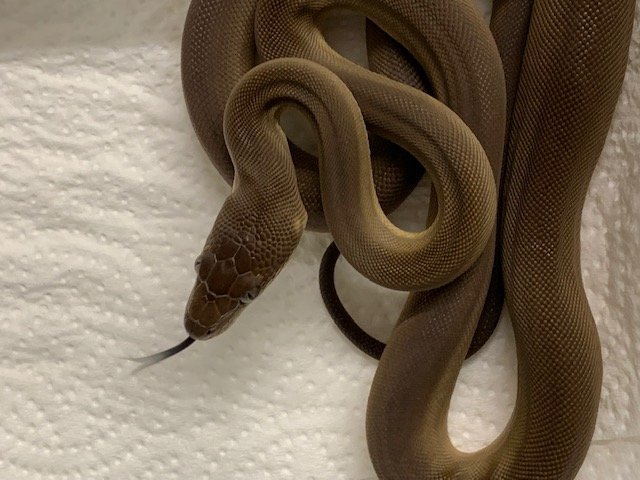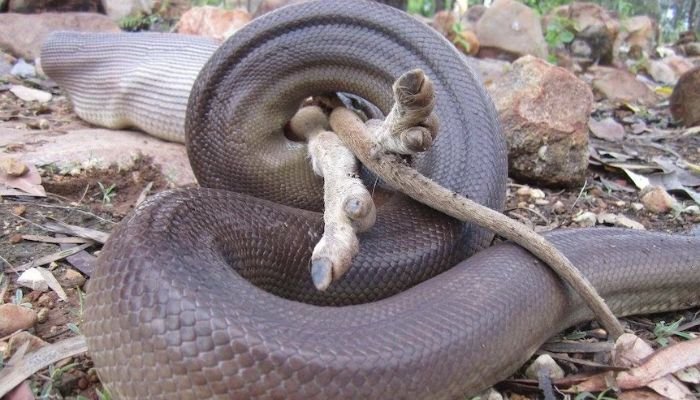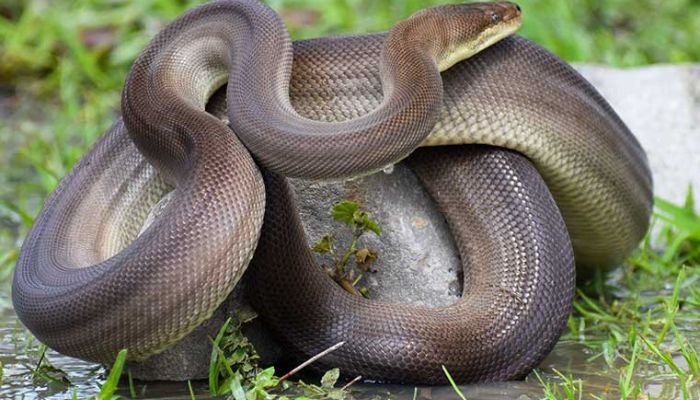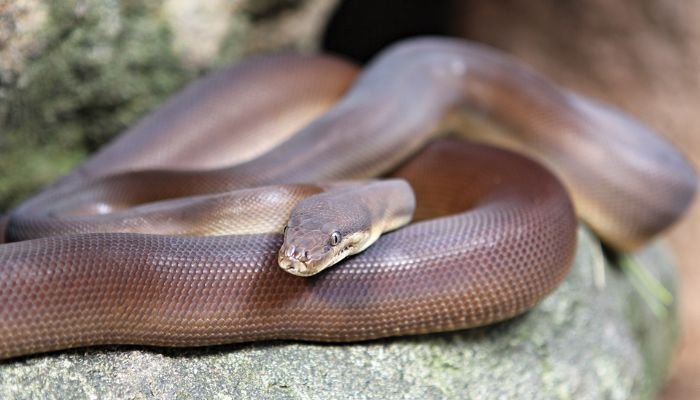
The Olive Python, which is large and resilient, is native to Australia. The Olive Python is a well-known reptile of the Australian wilderness, distinguished by its enormous size, muscular build, and olive-brown hue. It is a nonvenomous constrictor that feeds on various species of mammals and animals. The Olive Python faces conservation difficulties due to habitat degradation, traffic accidents, and persecution.. Here are Olive python Guide on Food, Habitat, Size, Lifespan & Predators below-
Olive Python Stats in Table format
The stats are given below for Olive python
| Reptiles List | Olive python |
|---|---|
| Family | Pythonidae |
| Type | Snake |
| Size | Large |
| Length | Olive python: Up to 8-14 feet (2.4-4.3 meters) |
| Color | Olive python: Typically has a brown or olive coloration. |
| Weight | Olive python: Adult olive pythons can weigh between 20 to 40 pounds.. |
| Lifespan | 20-30 years (or more) |
| Reproduction | Oviparous, lays eggs |
| Gestation Periods | The gestation period for an olive python is approximately 2 to 3 months. |
| Endangered Status | Least Concern (IUCN Red List) |
| Features | Large size, muscular body, non-venomous |
| Country & Areas | Australia, Northern Territory |
Olive Python Natural Habitat and Distribution
Large and harmless, the Olive Python (Liasis olivaceus) can be found in its native Australia. It is also known as the Olive Rock Python. Throughout the northern parts of the continent, it can be found in a variety of habitats. This reptile species is very dependent on the protection and nesting opportunities provided by rocky outcrops, fissures, and caves. Their range includes the arid and semiarid regions of Western Australia, the Northern Territory, and a portion of Queensland.
Olive Python Physical Features and Adaptations
Here are some information about Olive Python Physical Features and Adaptations:
1. Body Structure
The Olive Python is a massive snake with exceptional muscle and strength. Lengths of adults have been measured at above 4 meters (almost 13 ft). They are streamlined for easy movement in the rocks of their native environment. Because of their slender build, they are able to hide in tiny cracks and holes in the rock.
2. Coloration and Patterns
Olive Pythons, as its name suggests, are primarily olive-brown in color, with occasional yellowish undertones. They are well-adapted to their rocky habitat thanks to the camouflage provided by the darker patches and irregular patterns that cover much of their bodies.

3. Defense Mechanisms
Olive pythons are fearsome predators, yet they have defenses that help them survive. They have the ability to hiss loudly, swell their bodies, and strike when they feel threatened. Due of their lack of venom, they must rely on their superior constriction techniques to defeat prey and deter predators.
Olive Python Diet and Feeding Habits
Here are some information about Olive Python Diet and Feeding Habits:
1. Diet Type
Carnivorous by nature, Olive Pythons feast largely on rodents and shrews but will sometimes eat birds and even other snakes. Due to their lack of venom, they must rely on ambush and constriction to bring down their prey.
2. Preferred Food Sources
Rodents, opossums, bats, birds, and even other snakes are all fair game for these scaly predators. Olive Pythons feed primarily on rodents and birds when they are young, but as they mature, their diet shifts to include larger creatures.
3. Feeding Schedule
Olive Pythons in the wild engage in opportunistic hunting, and their feeding schedule is highly variable. They may go weeks or months without eating after a massive meal.
Olive Python Housing and Enclosure Requirements
Here are some information about Olive Python Housing and Enclosure Requirements:
1. Terrarium Size and Setup
Olive pythons need a lot of room to roam around in when they are kept as pets. A minimum of 8 square feet of floor space, 4 square feet of width, and 3 square feet of height is required for an adult snake terrarium. They can climb and sun themselves in an environment that looks like their natural rocky home, complete with branches and hiding holes.
2. Substrate Options
Aspen shavings, cypress mulch, or newspaper can serve as substrate in the enclosure. The snake will be able to move about easily on this surface, and the high humidity will be beneficial to its health.
3. Temperature and Lighting
Ectothermic means that Olive Pythons must rely on their environment to maintain a comfortable internal temperature. Creating a temperature gradient within the enclosure is crucial for captive animals. The perfect temperature range for a reptile is between 90 and 95 degrees Fahrenheit (32 and 35 degrees Celsius), with a colder portion between 75 and 80 degrees Fahrenheit (24 and 27 degrees Celsius). Calcium metabolism and general health depend on exposure to UVB rays.
4. Humidity and Water Needs
Olive Pythons have specific humidity and water requirements, ideally between 50 and 60%. If you give them a big bowl of water, they’ll always have something to drink and soak in, which will help them shed.
Olive Python Behaviour and Temperament
Here are some information about Olive Python Behaviour and Temperament:
1. Activity Levels
Olive Pythons are primarily active at night and in the early morning and late afternoon while in the wild. They hide during the day in cracks in the rocks to avoid the extreme temperatures.
2. Social Behaviour
The only time two Olive Pythons will ever meet in the wild is during the mating season or when they are vying for food or refuge.
3. Handling and Taming
Olive Pythons are tameable in captivity, but only if treated with extreme caution and patience. They can become less fearful of people if they are handled frequently, but they may still react defensively if they feel threatened.

Olive Python Breeding and Reproduction
Here are some information about Olive Python Breeding and Reproduction:
1. Mating and Courtship Rituals
Sexual reproduction in Olive Pythons takes place during the warmer months. During the courtship process, males will actively seek out females and perform elaborate body gestures that might last for hours. At that point, the female will proceed to lay eggs.
2. Incubation and Hatchlings
Clutches of eggs are laid by female Olive Pythons in secret places like caves and burrows. The eggs are allowed to incubate naturally, depending on the surrounding temperature for their growth. The young hatch after an incubation period of about 60 days to 70 days. They are self-sufficient from the moment they are born.
Olive Python Common Health Issues and Veterinary Care
Here are some information about Olive Python Common Health Issues and Veterinary Care
1. Respiratory Infections
Captive Olive Pythons are susceptible to respiratory diseases caused by unsuitable environmental conditions and careless management. Wheezing, increased mucus production, and fatigue are all symptoms of a respiratory illness.
2. Parasites
Mites and ticks, for example, can infest Olive Pythons if they are housed in filthy conditions. Parasite prevention relies on regular veterinary checkups and thorough housecleaning.
3. Metabolic Bone Disease
Metabolic bone disease manifests itself in captive Olive Pythons as weak bones and deformities due to insufficient exposure to UVB lighting and calcium shortages.
Importance of Regular Vet Check-ups
Captive Olive Pythons require routine veterinary care to ensure their wellbeing. A trained reptile vet can evaluate the snake’s health, make recommendations for its care, and spot potential problems before they become serious. The quality of life for these reptiles can be greatly enhanced with preventative care, such as regular parasite checks and keeping an appropriate enclosure environment.

Conclusion
The Olive Python is an interesting reptile because of its massive size, distinct coloring, and ability to thrive in its rocky environment. It has adapted to the harsh conditions of Australia through a combination of its streamlined body and protective measures. Successful captive husbandry requires familiarity with the species’ natural habitat, eating habits, and other unique needs. Olive Pythons can have long, healthy lives with the right care and attention from a veterinarian, allowing snake keepers and admirers to enjoy and learn from these fascinating animals. To ensure the Olive Python’s continuing survival in its native habitat, prudent care and conservation activities are necessary.
FAQs
Q: What is the family and Type of an Olive python?
A: The Olive python is a species of family Pythonidae. The Famous Olive python is a member of the family Snake.
Q: What is the average size of an Olive python?
A: The average adult Olive python is Large between Olive python: Up to 8-14 feet (2.4-4.3 meters).
Q: How long can an Olive python grow in size in lengths?
A: Olive python is Large in size and The olive python is a species of snake that can grow up to 8-14 feet (2.4-4.3 meters) in length.
Q: What colors do Olive python come in?
A: The olive python is known for its beautiful brown or olive coloration..
Q: How big can an Olive python get in weight?
A: The olive python is a species of snake that can reach adulthood and weigh anywhere from 20 to 40 pounds.
Q: What are the special Features of an Olive python?
A: Olive python are Large size, muscular body, non-venomous
Q: How long do Olive python live?
A: The usual lifespan of an Olive python is The Olive python, also known as the Liasis olivaceus, has a lifespan of approximately 20-30 years, although some individuals may live even longer.
Q: What food does the Olive python eat?
The olive python, like all pythons, is a carnivore, meaning it prefers to consume other animals, such as small mammals, birds, and reptiles. It is an ambush predator that kills its prey with a powerful constriction. An olive python’s prey can range from small mammals and birds to larger reptiles and even other snakes. They may fast for extended periods of time due to their slow metabolism.
Q: What is the best habitat for an Olive python?
Olive pythons thrive in a tropical or subtropical climate that features both forested and grassy areas. Originally from the northern part of Australia, their ideal climate features high humidity and temperatures between 80 and 90 degrees Fahrenheit. The python’s ideal environment would provide numerous places for it to hide, such as underbrush, rocks, and other debris. They can scale nearly any vertical surface, but they specifically require trees and branches. The ability to drink and soak in a body of water, such a pond or stream, is crucial. Small mammals, birds, and reptiles are all good prey to have in the area. The Olive python relies on a climate that is just right and a habitat that is rich in vegetation and provides plenty of hiding places.
Q: How do Olive python give birth?
A: Olive python are Oviparous, lays eggs
Q: How long is the gestation period for an Olive python?
A: The gestation period of an Olive python is approximately The gestation period for an olive python is approximately 2 to 3 months.
Q: What is the natural behavior of an Olive python?
Almost all Olive pythons are The Olive python is largely nocturnal in its natural activity, meaning it is most active at night. Australians have their own harmless snake species. Species of this genus can grow to a whopping 13 feet in length! Olive pythons are able to adapt to a wide variety of environments thanks to their superior climbing and swimming abilities. They use their camouflage to conceal in the environment and ambush their prey. They mostly eat reptiles, birds, and small animals. Only during the breeding season do olive pythons ever congregate. They tend to be tame snakes, but if they feel threatened, they may strike out.
Q: Is the Olive python endangered?
A: The Olive python is Least Concern (IUCN Red List).
Q: What are the prey of Olive python?
The Olive python eats rodents, birds, and reptiles, among other small mammals. In an ambush, it waits in concealment until its victim approaches within striking distance. The python uses its formidable size and strength to choke and then devour its prey. It is an opportunistic hunter that will take advantage of any available meal, including larger animals like wallabies and possums.
Q: Do Olive python have any Predators?
Olive pythons, the answer is Predators of the olive python include larger snakes like the king cobra and birds of prey like eagles and hawks. Crocodiles and other reptiles like monitor lizards are also a threat. The olive python may fall victim to these predators because of its size and strength. The olive python, however, is a strong predator in its own right, capable of hunting and eating a wide range of animals.
Q: How Fast Does Olive python Move?
A: The olive python can move at speeds of up to 5 miles per hour.
Q. What is Bite Force of Olive python in PSI?
A. Bite Force in PSI of an Olive python is not specified.
Q: Can we keep Olive python as pets?
The answer is yes; olive pythons make great house pets. They don’t bite, so you can keep them as pets if you treat them right. However, a wide habitat and a diet of small mammals are necessities for these creatures. Before deciding to keep one as a pet, you need learn about its unique requirements.
I hope you like reading on Olive Python FAQ Guide on Food, Habitat, Size, Lifespan and Predators.
